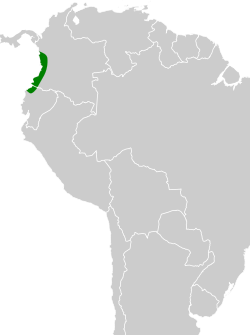Top Qs
Timeline
Chat
Perspective
Stub-tailed antbird
Species of bird From Wikipedia, the free encyclopedia
Remove ads
The stub-tailed antbird (Sipia berlepschi) is a species of bird in subfamily Thamnophilinae of family Thamnophilidae, the "typical antbirds". It is found in Colombia and Ecuador.[2]
Remove ads
Taxonomy and systematics
The stub-tailed antbird has a complicated taxonomic history. It was described by the German ornithologist Ernst Hartert in 1898 and given the binomial name Pyriglena berlepschi. The species was named to honor the German ornithologist Hans von Berlepsch.[3] In 1924 it was moved to genus Sipia, and later Sipia was merged into genus Myrmeciza.[4][5] A molecular phylogenetic study published in 2013 found that genus Myrmeciza, as then defined, was polyphyletic. In the resulting rearrangement to create monophyletic genera, genus Sipia was resurrected, and the stub-tailed antbird and several other species were moved to it.[6][2] The stub-tailed antbird is monotypic.[2]
Remove ads
Description
The stub-tailed antbird is 13.5 to 14.5 cm (5.3 to 5.7 in) long. Adult males are almost entirely black, with a white patch between their scapulars. Adult females are also mostly black, with white dots on the tips on their wing coverts and white spots on their throat, breast, and upper belly. Those on the belly sometimes have a scaly pattern. Both sexes have a deep red iris.[7][8][9]
Distribution and habitat
The stub-tailed antbird is found from central Chocó Department in western Colombia south into northwestern Ecuador's Esmeraldas Province. It is a bird of the Chocó Endemic Bird Area. There it inhabits the understorey of evergreen forest in the wet lowlands and foothills. It favors the forest edge, overgrown openings within the forest, and adjacent mature secondary forest. In elevation it mostly ranges from near sea level to 400 m (1,300 ft) though locally it reaches 650 m (2,100 ft).[7][8][9]
Behavior
Movement
The stub-tailed antbird is believed to be a year-round resident throughout its range.[7]
Feeding
The stub-tailed antbird feeds primarily on insects and probably includes other arthropods in its diet. Individuals, pairs, and family groups forage in dense vegetation on the ground and up to about 2 m (7 ft) above it. It seldom joins mixed-species feeding flocks but sometimes attends army ant swarms to capture prey that flees from the ants.[7][8][9]
Breeding
Nothing is known about the stub-tailed antbird's breeding biology.[7]
Vocalization
The stub-tailed antbird's song is "a series of downslurred notes that first drop and then rise in pitch, e.g., 'chi-chu-chu-chu-chew-chéw-chéw-chéw' ". Its calls include "a sharp 'chit' and a 'ch-dit' ".[9]
Remove ads
Status
The IUCN has assessed the stub-tailed antbird as being of Least Concern. Its population size is not known and is believed to be stable. No immediate threats have been identified.[1] It is considered uncommon in Colombia and uncommon to locally fairly common in Ecuador.[7][8] "Most existing Chocó reserves are centred on montane areas, leaving the biologically diverse lowlands and lower foothills relatively unprotected. Establishment of more reserves in this elevational zone is needed."[7]
Remove ads
References
Wikiwand - on
Seamless Wikipedia browsing. On steroids.
Remove ads




